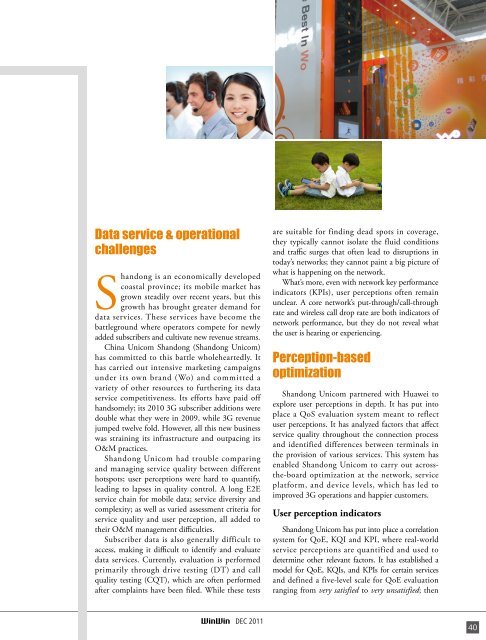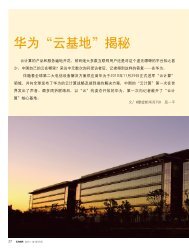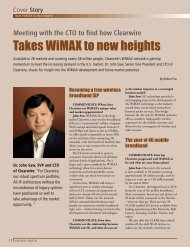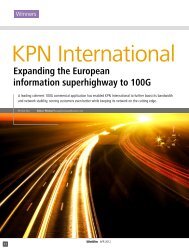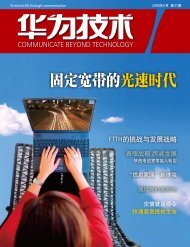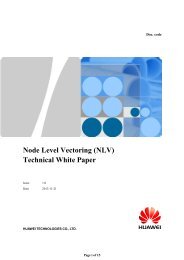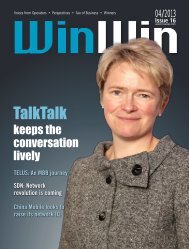Telekom Malaysia - Huawei
Telekom Malaysia - Huawei
Telekom Malaysia - Huawei
Create successful ePaper yourself
Turn your PDF publications into a flip-book with our unique Google optimized e-Paper software.
Data service & operational<br />
challenges<br />
Shandong is an economically developed<br />
coastal province; its mobile market has<br />
grown steadily over recent years, but this<br />
growth has brought greater demand for<br />
data services. These services have become the<br />
battleground where operators compete for newly<br />
added subscribers and cultivate new revenue streams.<br />
China Unicom Shandong (Shandong Unicom)<br />
has committed to this battle wholeheartedly. It<br />
has carried out intensive marketing campaigns<br />
under its own brand (Wo) and committed a<br />
variety of other resources to furthering its data<br />
service competitiveness. Its efforts have paid off<br />
handsomely; its 2010 3G subscriber additions were<br />
double what they were in 2009, while 3G revenue<br />
jumped twelve fold. However, all this new business<br />
was straining its infrastructure and outpacing its<br />
O&M practices.<br />
Shandong Unicom had trouble comparing<br />
and managing service quality between different<br />
hotspots; user perceptions were hard to quantify,<br />
leading to lapses in quality control. A long E2E<br />
service chain for mobile data; service diversity and<br />
complexity; as well as varied assessment criteria for<br />
service quality and user perception, all added to<br />
their O&M management difficulties.<br />
Subscriber data is also generally difficult to<br />
access, making it difficult to identify and evaluate<br />
data services. Currently, evaluation is performed<br />
primarily through drive testing (DT) and call<br />
quality testing (CQT), which are often performed<br />
after complaints have been filed. While these tests<br />
are suitable for finding dead spots in coverage,<br />
they typically cannot isolate the fluid conditions<br />
and traffic surges that often lead to disruptions in<br />
today’s networks; they cannot paint a big picture of<br />
what is happening on the network.<br />
What’s more, even with network key performance<br />
indicators (KPIs), user perceptions often remain<br />
unclear. A core network’s put-through/call-through<br />
rate and wireless call drop rate are both indicators of<br />
network performance, but they do not reveal what<br />
the user is hearing or experiencing.<br />
Perception-based<br />
optimization<br />
Shandong Unicom partnered with <strong>Huawei</strong> to<br />
explore user perceptions in depth. It has put into<br />
place a QoS evaluation system meant to reflect<br />
user perceptions. It has analyzed factors that affect<br />
service quality throughout the connection process<br />
and identified differences between terminals in<br />
the provision of various services. This system has<br />
enabled Shandong Unicom to carry out acrossthe-board<br />
optimization at the network, service<br />
platform, and device levels, which has led to<br />
improved 3G operations and happier customers.<br />
User perception indicators<br />
Shandong Unicom has put into place a correlation<br />
system for QoE, KQI and KPI, where real-world<br />
service perceptions are quantified and used to<br />
determine other relevant factors. It has established a<br />
model for QoE, KQIs, and KPIs for certain services<br />
and defined a five-level scale for QoE evaluation<br />
ranging from very satisfied to very unsatisfied; then<br />
DEC 2011<br />
40


